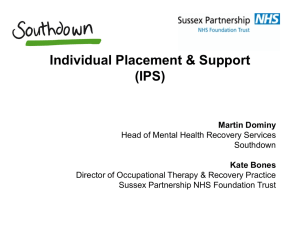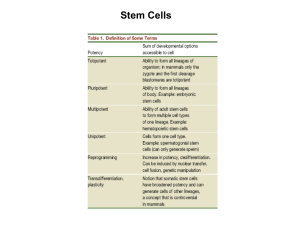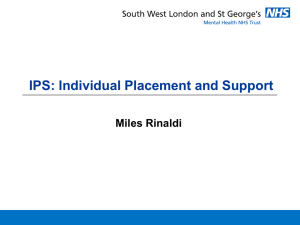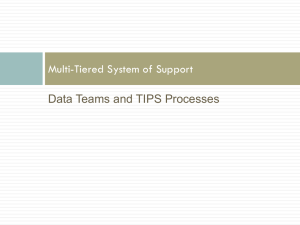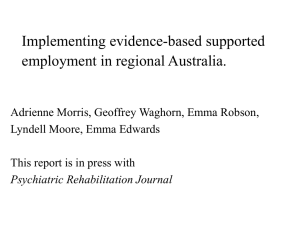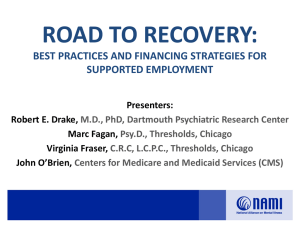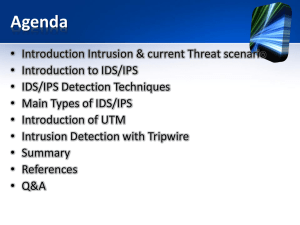EQOLISE
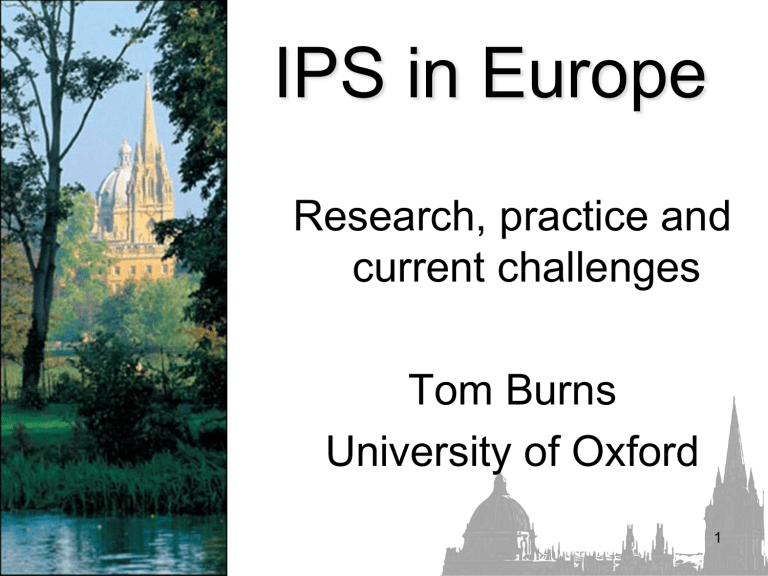
IPS in Europe
Research, practice and current challenges
Tom Burns
University of Oxford
1
Principles of IPS
1. Competitive employment
2. Open to anyone who wants to work
3. Rapid job search
4. Attention to client preferences
5. Time-unlimited support
6. Integrated with mental health care
7. Personalised benefits counselling
4
US evidence
• >13 studies (5 RCTs) consistently and overwhelmingly favour IPS over train and place
• 20–60% obtain jobs in IPS
• 10–20% in train and place
• Accepted as the evidence-based standard
5
Why, then, a European study?
• Good evidence from Assertive Community
Treatment literature that Mental Health
Services research into complex interventions may not travel
• Opportunity to exploit differences in
European context to illuminate processes
6
US and Europe very different
• Employment culture
– US ‘hire and fire’ versus European employment protection and stability
• Welfare state provision
– European benefits generally higher
– Varies considerably across Europe
7
Benefit trap
• Benefits > Salaries
– Benefits to make up shortfall in salary;
–
UK, NT
• Benefits ≈ salaries
– Benefits linked to previous income;
– DE & SW
• Benefits < salaries
– BG & IT (like USA)
9
10
Design and Method
• Randomised control trial (RCT) in six European countries
• Comparing ‘place and train’ (IPS) with ‘train and place ’
• Psychotic patients with extensive unemployment
• Randomisation at the patient level,
– Stratified using minimisation technique by:
– Centre, gender and work history
• N=300, 50 from each centre
• Assessments at baseline, 6, 12 and 18 months
• Primary outcome open employment for one day
11
Three questions
1. Is IPS effective in Europe?
2. Is its effectiveness influenced by broader social factors?
3. Does return to work for SMI patients involve health risks?
13
Is IPS effective in
Europe?
14
Vocational outcomes
Difference between IPS and Vocational Services – vocational and hospitalisation outcomes
Outcome IPS Vocational Differenceª 95% CIª p-value
26.9% (16.4, 37.4) <0.001
Worked for at least one day 85 (54.5%) 43 (27.6%)
Number of hours worked a 428.8
(706.8)
119.1 (311.9) 308.7
(189.2, 434.2)
Number of days employed a 130.3
(174.1)
30.5 (80.1) 99.8% (70.7, 129.3)
Job tenure (days) a 213.6
(159.4)
108.4 (112.0) 104.9% (56.0, 155.0)
Drop-out from service
Hospitalized
Percentage of time spent in hospital
20 (12.8%) 70 (44.9%)
28 (20.1%) 42 (31.3%)
4.6 (13.6) 8.9 (20.1)
-32.1%
-11.2%
-4.3
(-41.5, -22.7)
(-21.5, -0.90)
(-8.40, -0.59)
<0.001
0.034
15
Is IPS affected by local socio-economic circumstances?
16
Worked for a day by centre
17
Socio-economic sources of heterogeneity
Local unemployment rates
GDP per capita growth
% GDP spent on health
Long term unemployment
Benefit trap
IPS effect
0.016
Getting a job
0.001
0.002
0.001
0.004
19
Effect of local unemployment rate on IPS vs outcomes
20
Effect of benefit trap on getting a job overall
21
Effect of benefit trap on
IPS effect size
22
Does returning to work make you ill?
23
Hospitalisation during study
Difference between IPS and Vocational Services – vocational and hospitalisation outcomes
Outcome
Worked for one day at least
IPS
85 (54.5%)
Vocational
43 (27.6%)
Difference
26.9%
95% CI
(16.4%,
37.4%) p-value
<0.001
Number of hours worked a 428.8
(706.8%)
119.1%
(311.9%)
308.7% (189.22%,
434.17%)
Number of days employed a 130.3
(174.1%)
30.5 (80.1%) 99.8% (70.71%,
129.27%)
Job tenure (days) a 213.6
(159.4%)
108.4
(112.0%)
104.9% (56.03%,
155.04)
Drop-out from service
Hospitalized
Percentage of time spent in hospital
20 (12.8%) 70 (44.9%)
28 (20.1%)
4.6 (13.6%)
42 (31.3%)
8.9 (20.1%)
-32.1%
-11.2%
-4.3%
(-41.5%, -
22.7%)
(-21.5%, -
0.90%)
(-8.40%, -
0.59%)
<0.001
0.034
24
Conclusions
• IPS is twice as effective in obtaining employment in Europe as standard rehab
– 54.5% vs 27.6%
• Close to US levels
• Effect varies and is influenced by
– Local unemployment rates
– The benefit trap
• Patients are not made unwell by IPS
25
Current UK IPS Trials
• IPS + CBT module
• IPS + motivational interviewing
• IPS in first onset psychosis
• IPS-LITE
IPS-LITE
• 9 months, no job – refer back to MH team
– ‘perhaps not the right time’
– ‘welcome back if things change’
• 9 months in job
– 4 months persisting support with discharge clearly understood
– Back to MH team or discharge
Hypotheses
1. Less effective but higher throughput thus more cost beneficial
– Lower right hand corner of cost-benefit plane
2. More effective
– Focuses both client and job coach on getting on with it
What are the challenges?
SWAN Trial
29
30
What challenges from SWAN?
• IPS in high unemployment - recession
• Voluntary sector or Health services provision?
• Differences between US and UK management cultures for services
• Balancing principles
– Rapid job search vs client choice
• Training or quality control?
31
Thank you for you time
Greetings from Oxford
32
